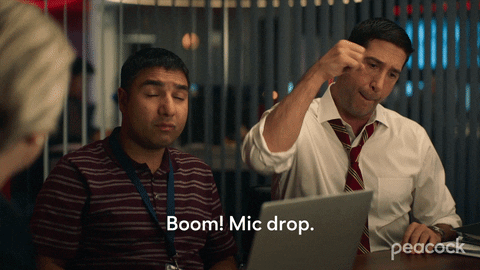Mic Drop #20: Success and Underperformance in Comcast's ($CMCSA) Strategy for Peacock
A surprising amount of transparency from Comcast implies it loves Peacock because it helps to tell the story for High Speed Internet
Exactly two months ago I wrote about “Peacock’s ($CMCSA) Quiet Pivot To Focus On Its Free and Premium Tiers”. At one point I looked at Peacock through the lens of two slides from the PARQOR Learnings from 2020, Predictions for 2021 deck, and a data point from ANTENNA Data, and concluded:
Peacock has weak product channel fit for not one but three different products – two of which rely on ads revenues- forcing it to rely almost exclusively on MVPD broadband “bundles” with Cox and Charter to scale its Premium tier; and,
The point was, Comcast relies unusually heavily on its own scale to drive Peacock sign-ups.
This week, CFO Michael Cavanagh broke down for attendees of the Deutsche Bank Virtual Media, Internet & Telecom Conference just how fundamental the Flex platform is to Comcast’s growth strategy for Peacock:
the second highest-rated new brand during the pandemic was Peacock, no small part due to the ability to drive through our various platforms, including Flex being one of them.
Now, the quote itself isn’t Mic Drop worthy.
But, I wrote in “Peacock’s ($CMCSA) Quiet Pivot” about the challenge of Peacock relative to Comcast’s Flex model:
The limits of Peacock’s model may be why Comcast wants to expand its X1 Infinity software into Smart TVs in partnership with Walmart, as the WSJ reported in November ($ – paywalled). As Roku has proven, there is higher ARPU from hardware sales and higher CPMs ($30+) for ad supported content models if Comcast pairs Peacock with its Xfinity software.
X1 software drives its Xfinity X1 Smart TV software, and its Flex platform.
This past week, The Information reported that “only 4% of Peacock’s 11.3 million regular users signed up for the ad-free option”, Cavanagh’s emphasis on Flex while discussing Peacock implied Comcast is already seeing the limits of Peacock’s model.
Comcast’s eyes on the prize seem to be more on scaling its X1 software than on scaling Peacock.
Peacock relies heavily on Flex and MVPD businesses
Flex is the only platform Cavanagh highlights in his comments about Peacock to the Deutsche Bank Conference. It mirrors something that Comcast CEO Brian Roberts told the Morgan Stanley Conference on March 3rd:
…one of my goals and one of our team's goals is to really step back and come back with, okay, now that we had this start better than we expected [with Peacock], what are we going to do about that? And we've seen, obviously, in the marketplace, consumers' adoption going even faster. We see that with our Flex boxes and in our Cable business, with usage and how well we've integrated streaming with our customers. And so we're not on every platform yet with Peacock, we're on most. We hope and believe we'll get to all the major platforms soon.
The bullets of the core message from both Cavanagh and Roberts are:
Peacock’s 33MM registered users have surpassed expectations;
Flex and Cable businesses have been core to that outcome; and
Peacock is on “most” platforms, and Roberts implies they will get to “all” soon (that was interpreted by some in the media as a reference to Amazon)
In emphasizing Flex and Cable businesses in driving Peacock sign-ups, Roberts and Cavanagh are telling us both Cox and Comcast (~37MM homes, combined) were key to driving Peacock sign-ups.1
If we wanted to be really skeptical, we could argue that 89% of sign-ups were driven by these two platforms. Now, there isn’t much evidence to support that math. But there also isn’t any evidence that third-party platforms are driving sign-ups either.
In fact, in the case of Peacock, it is important to note there isn’t much evidence of anything, as Gavin Bridge of Variety reported earlier this week in The Latest U.S. Trends for Free Streaming ($ - paywalled):
Privately, several major FAST services have expressed frustration with the lack of standard measurement and how the likes of Peacock and Roku game the system with inflated and meaningless stats.
It’s not unreasonable to argue that Comcast would not be able to “game the system” if it didn’t have scale across MVPD and broadband subscribers, and third parties had more transparency into Peacock’s numbers than Comcast. Even when third parties like The Information do get their hands on data, as above, 11.3MM, or 1/3 of the 33MM registered users, are “regular users”, of whom 4%, or 452,000, pay for no ads one year into Peacock’s existence.
This leads to two mic drops:
First, 452,000 Premium Plus subscribers, or 1.3% of 33MM registered users, suggests I was right that the Charter announcement in January reflected how Peacock had “simplified its business objectives to focus on its advertising business, and reduced any reliance on trying to sell its Premium Plus tier”.
Second, the available data implies just how heavily Comcast is relying on its own MVPD model to scale Peacock. Not worth a mic drop, but a mini celebration.
A Quick Additional Note on Comcast’s Strategy
It’s worth highlighting here that Roberts and Cavanagh emphasized 3MM Flex boxes, and Cavanagh shed some additional light on Comcast’s strategy with Xfinity and Flex:
Not everyone, as we know, given all the forces at work in the media marketplace, want to have the traditional bundle or the modified bundles that we've increasingly brought to cater to different types of customer needs. And while we might have thought that a little bit years ago, I mean we clearly embraced where the world is going with the idea of we have an opportunity to attach to our broadband the kind of brains that goes in X1, to aggregate all that and ingest all that video, staple it to our navigation tools, including the voice remote. And for free, give someone Flex.
And that we're seeing -- so the business rationale is as video itself was to -- primarily to make sure we bring down churn in the broadband business, the center of the plate product. We don't -- many people are worried we'd chase holding on to a video bundle even if it went upside down on us economically, and we are very eager to continue to super serve the segment of the market that values the full bundle that we think is fantastic, and you get that through X1.
Reading this, the suggestion is Flex software and X1 video bundling are more valuable to Comcast’s broadband business than Peacock. Why are they more valuable? In the case of Flex, it helps to reduce broadband customer churn:
…Flex gives us the ability to get the same churn reduction benefit that being at the end of the pipe and providing a service. And so we see 15% to 20% reduction in churn for a broadband customer only with Flex versus a broadband customer without. That's what we wanted to see. That's what we are seeing.
The longer term vision for Flex is to become “a platform to do more”:
Obviously, we are a marketer of services for a variety of streaming services. And I think we've -- I think if you're a big streaming service, you look at the success we've had with some of the leading streamers out there of integrating them and helping them sell their products. I think we increasingly look at the lens for monetization of that type of activity.
Peacock lost $914M in 2020, according to a recent SEC filing from Comcast reflecting a change its presentation of segment operating results relating to NBCUniversal. But High-Speed Internet drove $20.6B in revenues for Comcast in 2020.
The takeaway from both Roberts’ and Cavanagh’s presentations is that Flex, and therefore its High-Speed Internet division, is a sexier business than Peacock. Peacock helps to tell that story for Flex, because Flex helped to create “the second highest-rated new brand during the pandemic…, no small part due to the ability to drive through our various platforms, including Flex being one of them.”
In turn, Flex and Peacock help to tell a story about the power of its X1 software. Comcast loves Peacock because it helps tell the growth story for High Speed Internet business, and its broader market ambitions for its Flex software (like Smart TVs and OTT devices).
If Peacock has 33MM registered users, that story seems to be about the power of Comcast’s scale and software, but not about demand for Peacock.
An emphasis on Flex and Cable is implicitly an emphasis on Comcast’s reach plus MVPD broadband “bundles”. For example, Central to Comcast’s partnership with Cox is the Xfinity Flex software platform, which Cox licenses for its Contour Stream streaming player. So, Flex is in both Comcast and Cox broadband homes.







